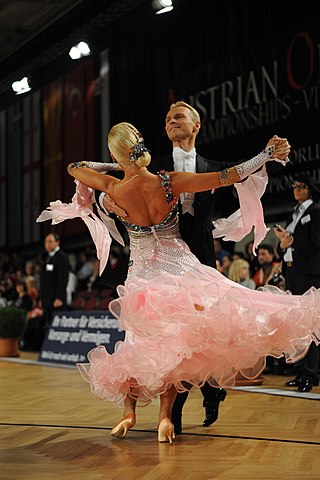A whisk is a kitchen utensil
Whisk may also refer to:
- Fly-whisk, used as a flyswatter or as regalia
- Whisk broom, a kind of broom, a cleaning instrument
- Whisk (ballroom dance), a ballroom dance step used in waltz
- see also
- IBM/Apache's OpenWhisk
A whisk is a kitchen utensil
Whisk may also refer to:

Ballroom dance is a set of partner dances, which are enjoyed both socially and competitively around the world, mostly because of its performance and entertainment aspects. Ballroom dancing is also widely enjoyed on stage, film, and television.

A broom is a cleaning tool consisting of usually stiff fibers attached to, and roughly parallel to, a cylindrical handle, the broomstick. It is thus a variety of brush with a long handle. It is commonly used in combination with a dustpan.

Viennese waltz is a genre of ballroom dance. At least four different meanings are recognized. In the historically first sense, the name may refer to several versions of the waltz, including the earliest waltzes done in ballroom dancing, danced to the music of Viennese waltz.
This is a list of dance terms that are not names of dances or types of dances. See List of dances and List of dance style categories for those.
Formation dance is a style of ballroom dancing. It is pattern or shadow team dancing by couples in a formation team. The choreography may be based on a particular dance or a medley of dances. Formation dancing may be done for exhibition or for competition between teams. There is also a type of formation in Bhangra.
In many forms of dance medal examinations are held. They are organised by leading dance teaching organisations, such as the Imperial Society of Teachers of Dancing (ISTD), the International Dance Teachers Association (IDTA), and other organisations.

Frank Manning was an American dancer, instructor, and choreographer. Manning is considered one of the founders of Lindy Hop, an energetic form of the jazz dance style known as swing.

Commodore Ballroom is a music venue, dance floor and nightclub located on 800 block of Granville Street in Vancouver, British Columbia. It is regarded as Canada's most influential nightclub, and one of North America's best live music venues. The building was built in the Art Deco style of the late 1920s by George Conrad Reifel and designed by architect H.H. Gillingham. Best known for showcasing special performances, the venue is also known for its sprung dance floor, whose horsehair lining absorbs, rather than reflecting back, some of the impact of dancers' feet. At the time it was installed, only a few venues in the world had similar floors.
Shuffling is a procedure used to randomize a deck of playing cards.

Waltz is one of the five dances in the Standard category of the International Style ballroom dances. It was previously referred to as slow waltz or English waltz.
The Metropolitan Handicap, frequently called the "Met Mile", is an American Grade I Thoroughbred horse race held at Belmont Park in Elmont, New York. Open to horses age three and older, it is contested on dirt over a distance of one mile. Starting in 2014, it is now run on the same day as the Belmont Stakes in early June.

Whisk Broom II (1907–1928) was an American-bred Thoroughbred racehorse who raced in the United Kingdom and in the United States. Whisk Broom showed high class form during four seasons of racing in Europe, but produced his best performances when returning to America in 1913. He claimed the New York Handicap Triple by winning the Metropolitan Handicap, the Brooklyn Handicap, and the Suburban Handicap, a feat unmatched until Tom Fool achieved it forty years later. Kelso in 1961 and Fit To Fight in 1984 later joined them as the only other horses to win the Handicap Triple. Whisk Broom II's career was ended by injury after his triple success, but he went on to become a successful breeding stallion.

A whisk broom or spotlight sensor, also known as an across-track scanner, is a technology for obtaining satellite images with optical cameras. It is used for passive remote sensing from space. In a whisk broom sensor, a mirror scans across the satellite’s path, reflecting light into a single detector which collects data one pixel at a time.

A push broom scanner, also known as an along-track scanner, is a device for obtaining images with spectroscopic sensors. The scanners are regularly used for passive remote sensing from space, and in spectral analysis on production lines, for example with near-infrared spectroscopy used to identify contaminated food and feed. The moving scanner line in a traditional photocopier is also a familiar, everyday example of a push broom scanner. Push broom scanners and the whisk broom scanners variant are often contrasted with staring arrays, which image objects without scanning, and are more familiar to most people.
The whisk is a ballroom dance step used in the waltz and American style Viennese waltz. It is one of several ways to get into promenade position and is used to turn dancers around corners or change their direction on the dance floor. It can be performed after a reverse turn.
A natural turn is a dance step in which the partners turn around each other clockwise. Its near-mirror counterpart is the reverse turn, which is turning to the counter-clockwise.
The Telemark is a ballroom dance step; in waltz competition, it is in the Silver syllabus. Telemarks are reverse turns where the follower does a heel turn as the leader travels around her. There are similar Telemarks in foxtrot and quickstep.
A wing is a ballroom dance move, in the silver syllabus of competition waltz. It is a transitional movement that repositions the follower to the leader's left side. Thus, while many dance moves can precede a wing, only a reverse movement can follow a wing, such as a reverse turn, double reverse spin, Telemark, fallaway reverse, or drag hesitation.

Guardians of Oz is a 2015 Mexican-Indian 3D computer animated adventure film, directed by Alberto Mar and executive produced by Jorge Gutierrez. The film was produced by Ánima Estudios, Discreet Arts, and distributed by FilmSharks International. The film is the first English-language and flagship CG production for Ánima Estudios, as well as the studio's biggest production and is described as Mexico's biggest animated production. Mexico's take on the early 20th century Wizard of Oz books by L. Frank Baum, it features an original story and new characters, and was released theatrically on 10 April 2015 in Mexico.